VI.2.4 Pompeii. Casa di Sallustio or House of Sallust or Domus A. Cossius Libanus.
Excavated 1805 to 1809, 1969 to 1971, 2005 to 2007 and 2010.
Bombed 1943. Restored 1970.
Part 1 Part
2 Part 3 Part
4 Part 5 Part
6 Part 7 Part 8 Part
9 Plan

VI.2.4 Pompeii. May 2006. Looking west along south side of small garden.

VI.2.4 Pompeii. Undated paintings from south-west corner of peristyle.
DAIR 83.63. Photo
© Deutsches Archäologisches Institut, Abteilung Rom, Arkiv.

VI.2.4 Pompeii. 1902. Watercolour by Luigi Bazzani. Looking towards room in south-west corner of garden area.
Now in Naples Archaeological Museum, inv. no. 139439

VI.2.4 Pompeii. Undated 19th century sketch by A. Aurelj.
Garden painting, showing remains of Phrixus and Helle, from above the side window of the cubiculum in the south-west corner of garden.
This was destroyed in 1943.
DAIR 83.64. Photo
© Deutsches Archäologisches Institut, Abteilung Rom, Arkiv.

VI.2.4 Pompeii. 1824. Drawing of south wall of garden with rooms on either side of the painting of Diana and Acteon.
See Mazois, F., 1824. Les Ruines de Pompei : Second Partie. Paris: Firmin Didot. (pl. 39, 1).
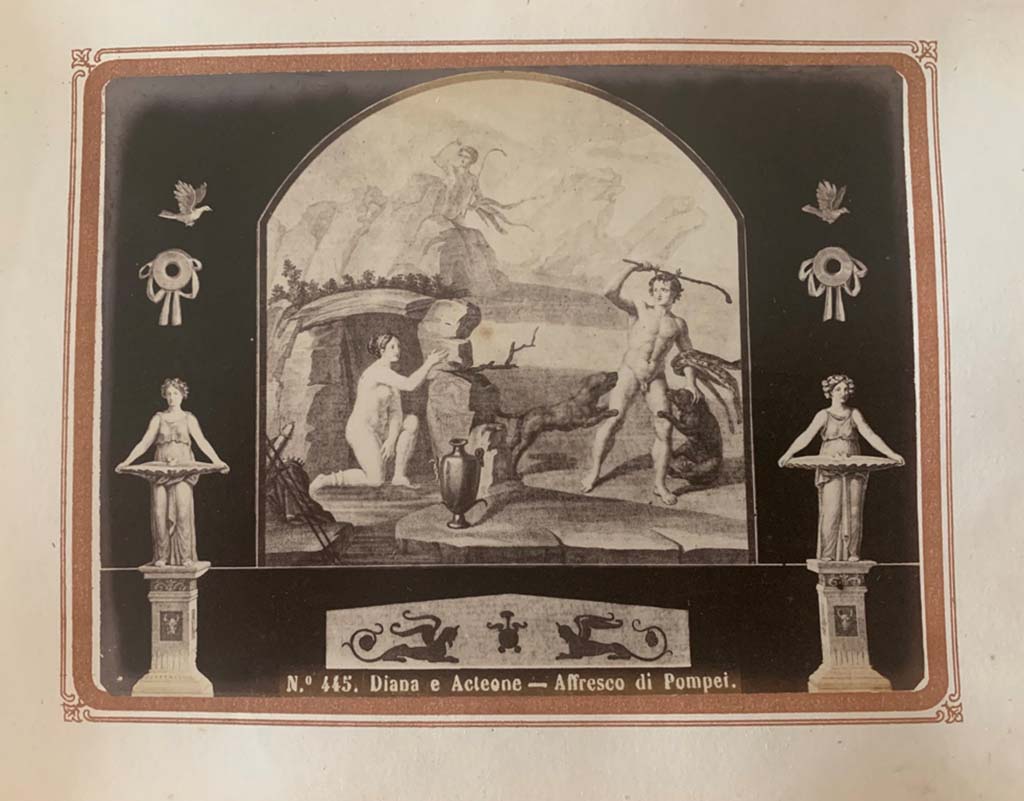
VI.2.4 Pompeii. From
an album by Roberto Rive, dated 1868.
Painting seen on south wall of garden area. Photo courtesy of Rick Bauer.
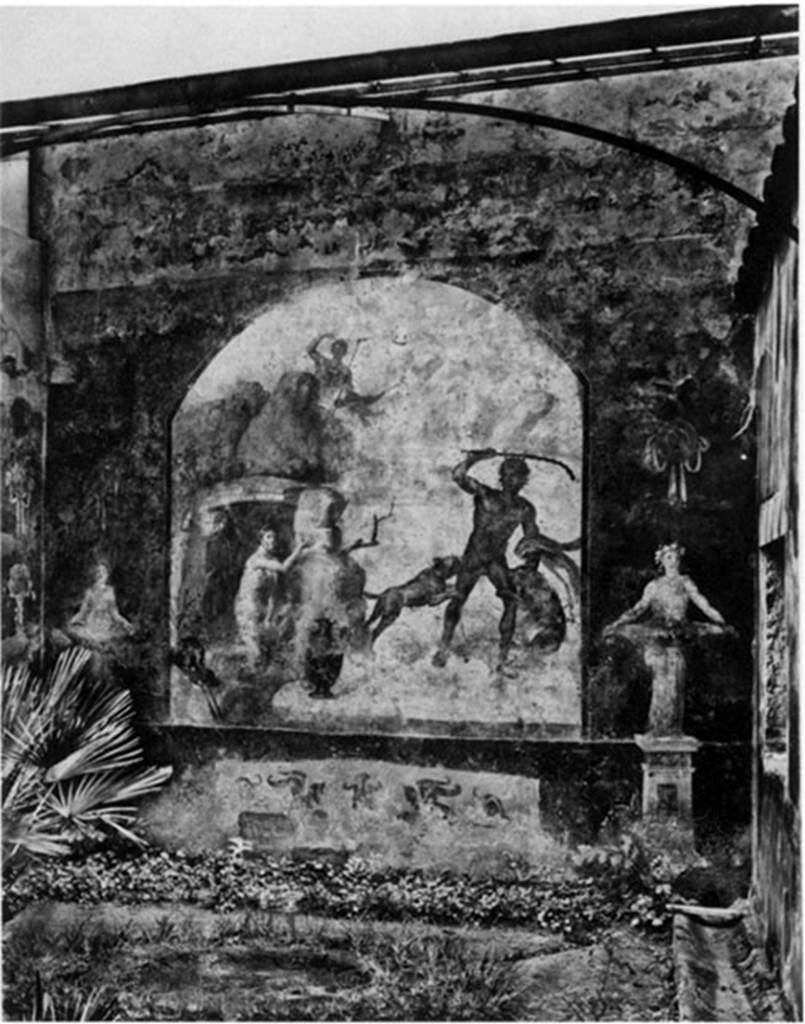
VI.2.4 Pompeii. South wall of garden. Old photo of painting of Acteon and Diana.
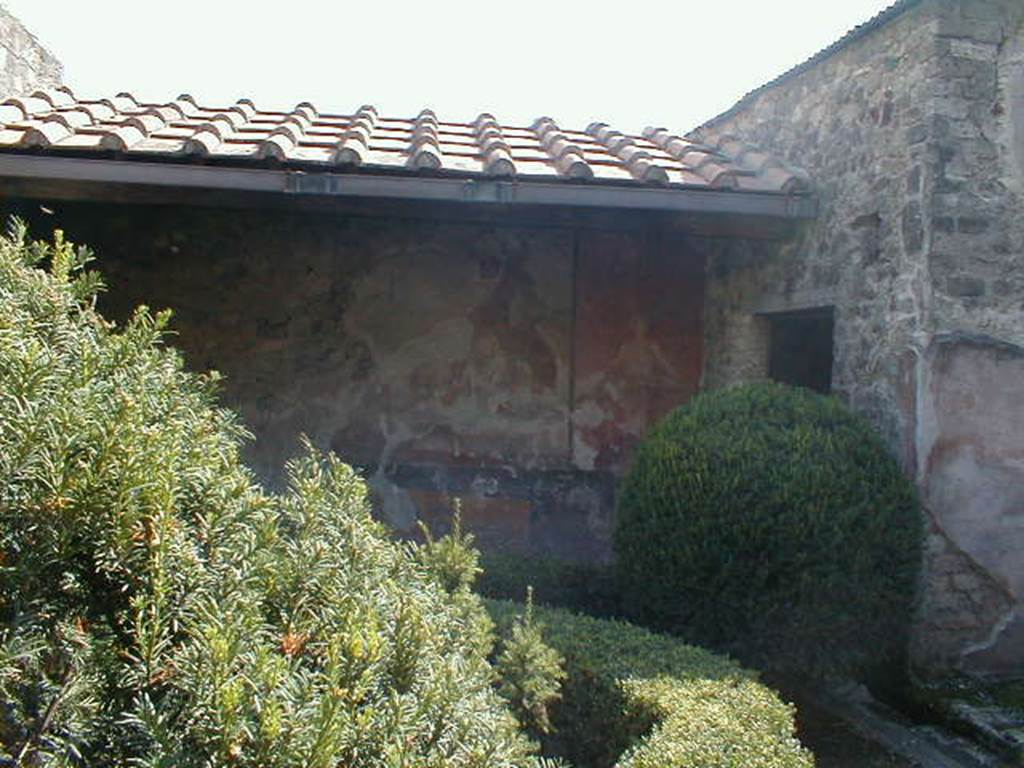
VI.2.4 Pompeii. May 2006. South wall of small garden.
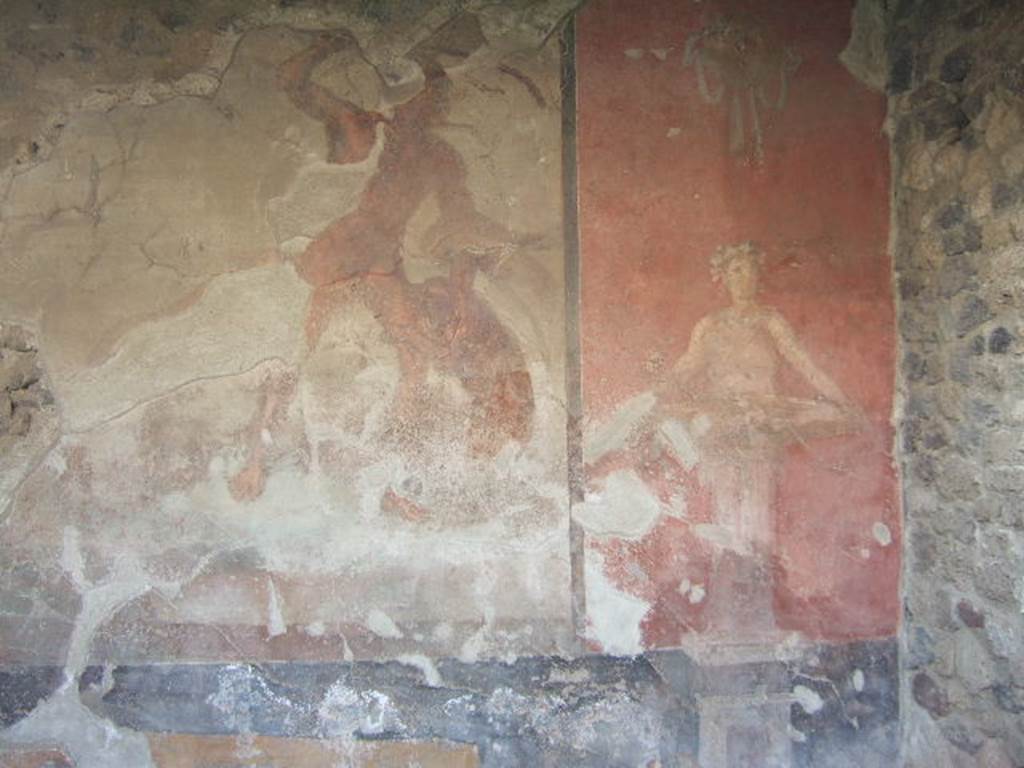
VI.2.4 Pompeii. May 2006. Wall painting of Acteon on south wall of small garden.
On the right is a nymph in guise of a statue holding a fountain bowl in her hand.
See Garcia y
Garcia, L., 2006. Danni di guerra a Pompei. Rome: L’Erma di Bretschneider. (p.70, T:121).
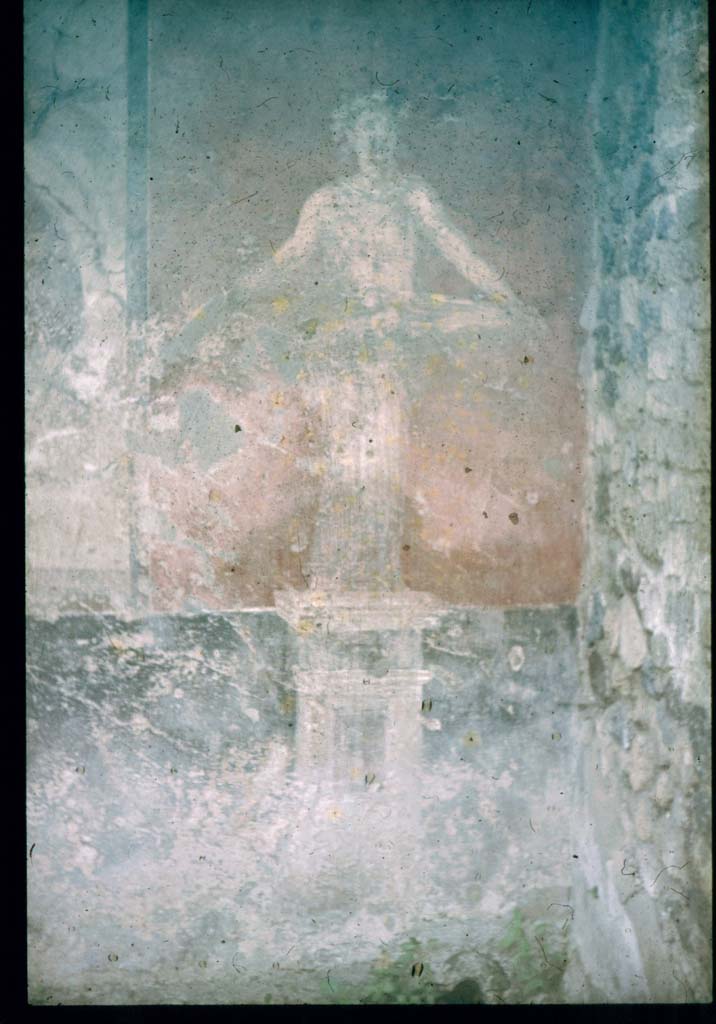
VI.2.4 Pompeii. Wall Painting of nymph.
Photographed 1970-79 by Günther Einhorn, picture courtesy of his son Ralf Einhorn.
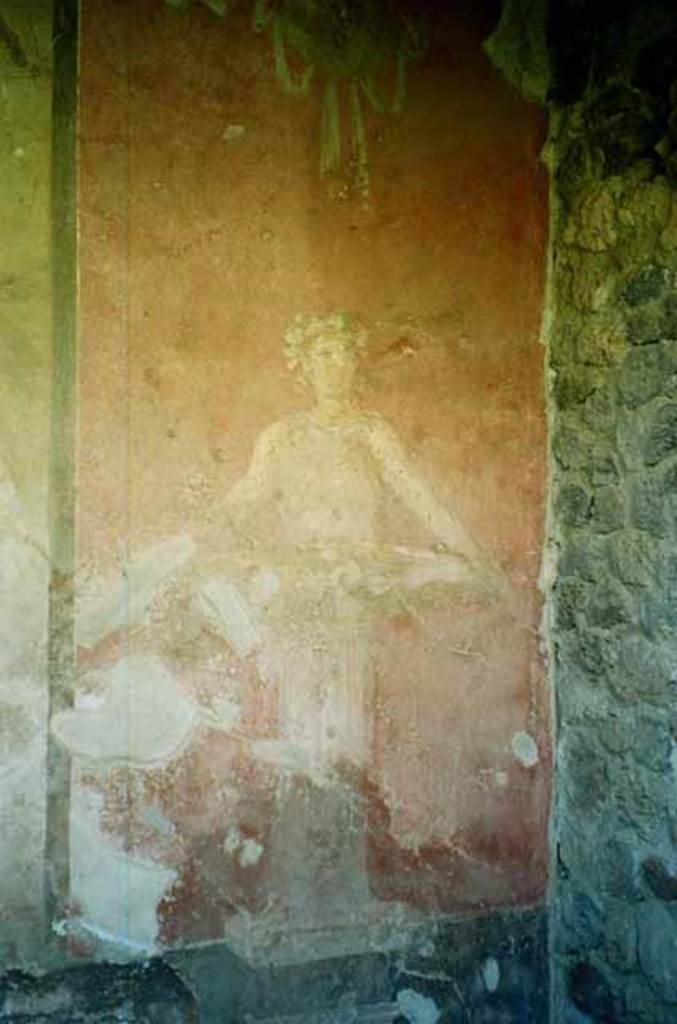
VI.2.4 Pompeii. June 2010. Wall painting of nymph. Photo courtesy of Rick Bauer.
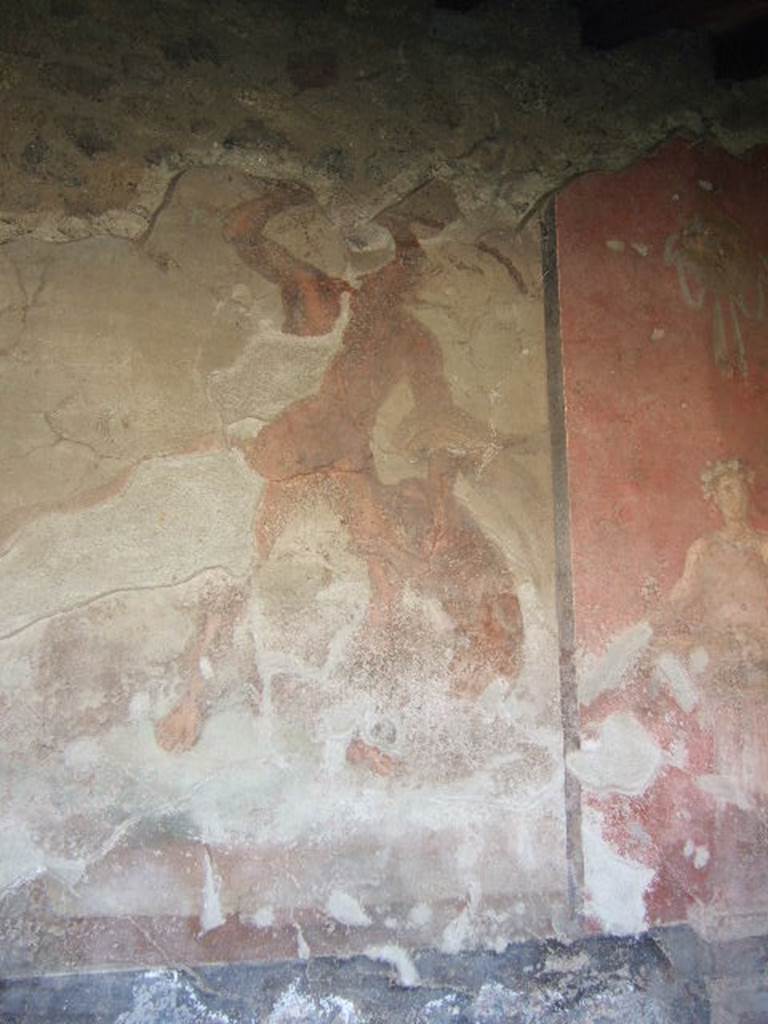
VI.2.4 Pompeii. May 2006. Wall painting on south wall of small garden.
The fate of Acteon who was torn to pieces by his own hounds as a penalty for having seen Diana at her bath.
See Mau, A., 1907, translated by Kelsey F. W. Pompeii: Its Life and Art. New York: Macmillan. (p.285).
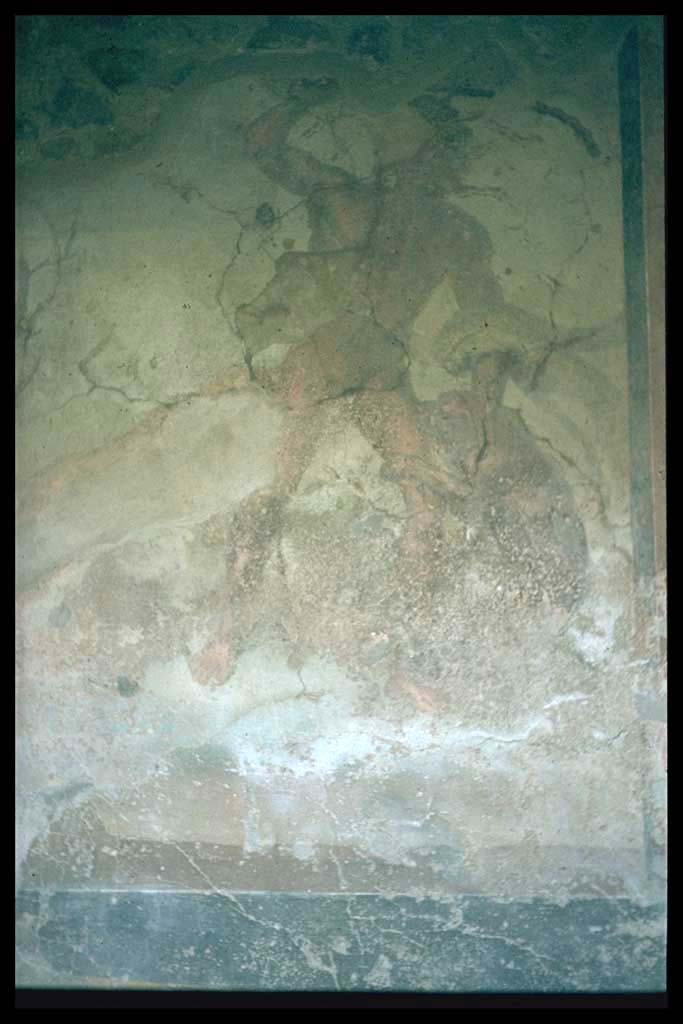
VI.2.4 Pompeii. Garden. Wall painting of Acteon.
Photographed 1970-79 by Günther Einhorn, picture courtesy of his son Ralf Einhorn.
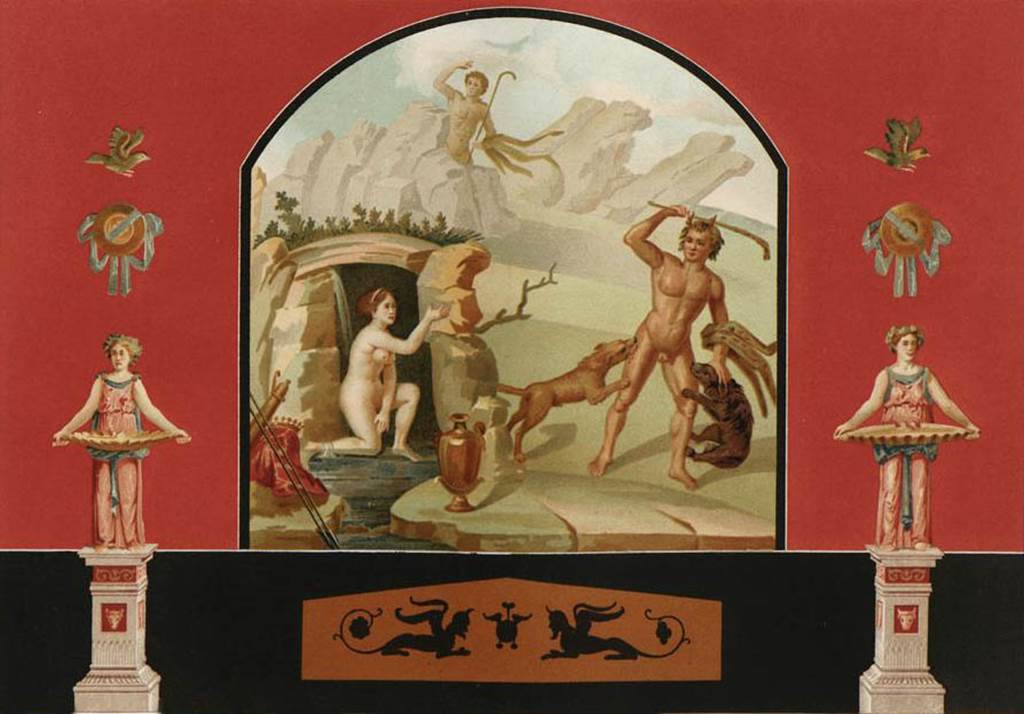
VI.2.4 Pompeii. 1830s. Old watercolour of the painting of Diana and Acteon from south wall.
See Niccolini F,
1890. Le case ed i monumenti di Pompei:
Volume Terzo. Napoli. (Casa detta di Sallustio, Tav III).
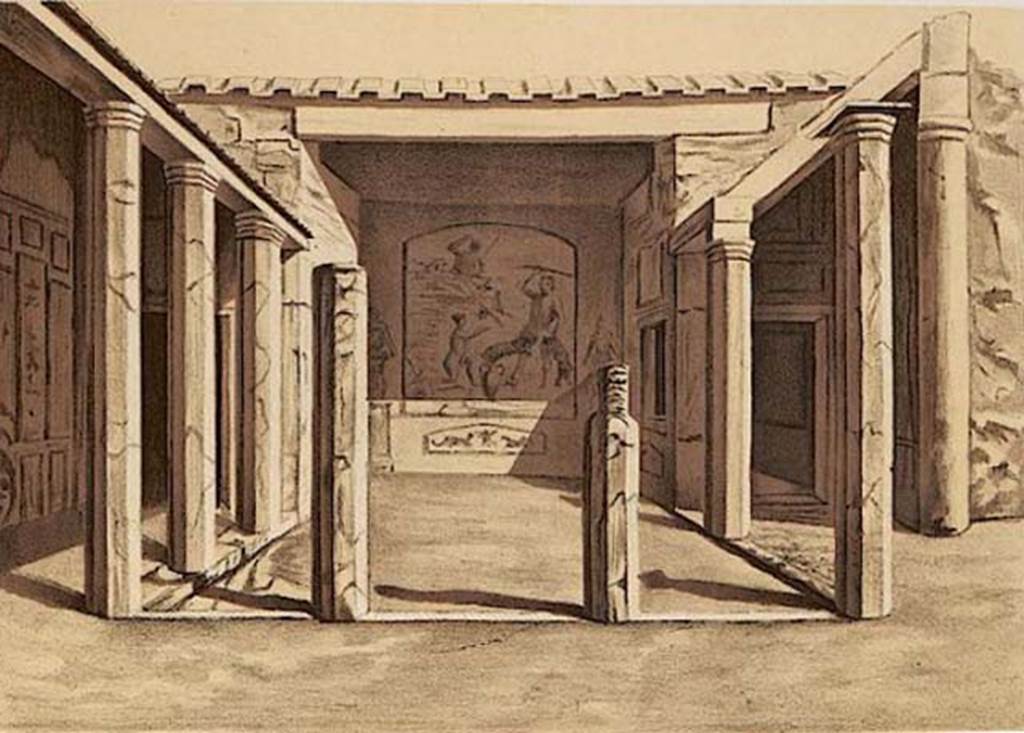
VI.2.4 Pompeii. 1896. Drawing of garden, looking south.
See Niccolini F, 1896. Le case ed i monumenti di Pompei: Volume Quarto. Napoli. (Saggi di Restauro, Tav F).
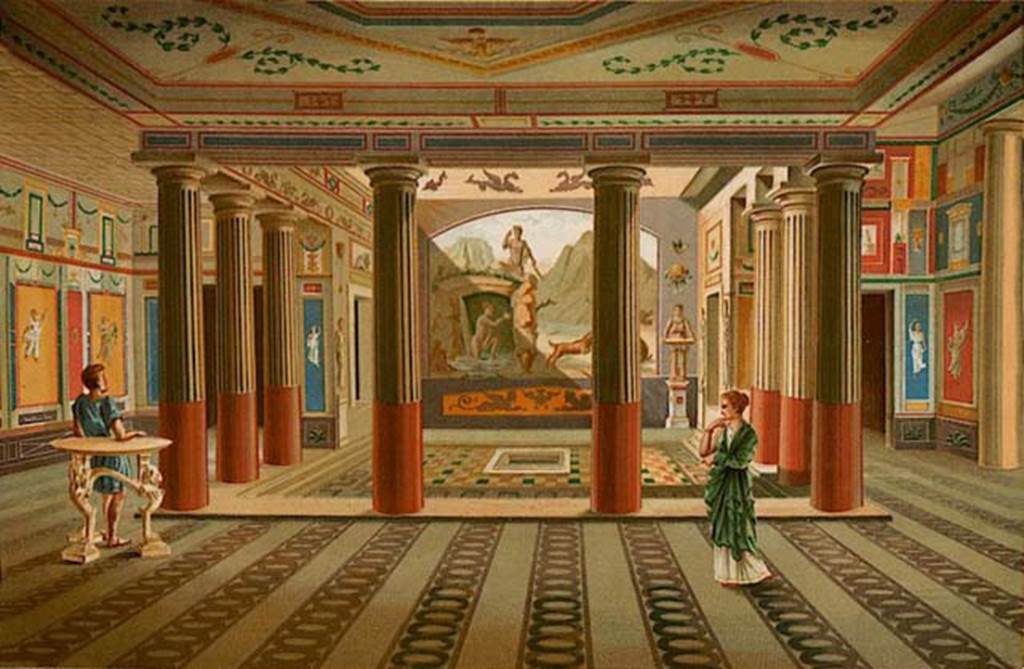
VI.2.4 Pompeii. 1896. Reconstruction of garden and peristyle, looking south.
See Niccolini F, 1896. Le case ed i monumenti di Pompei: Volume Quarto. Napoli. (Saggi di Restauro, Tav XI).
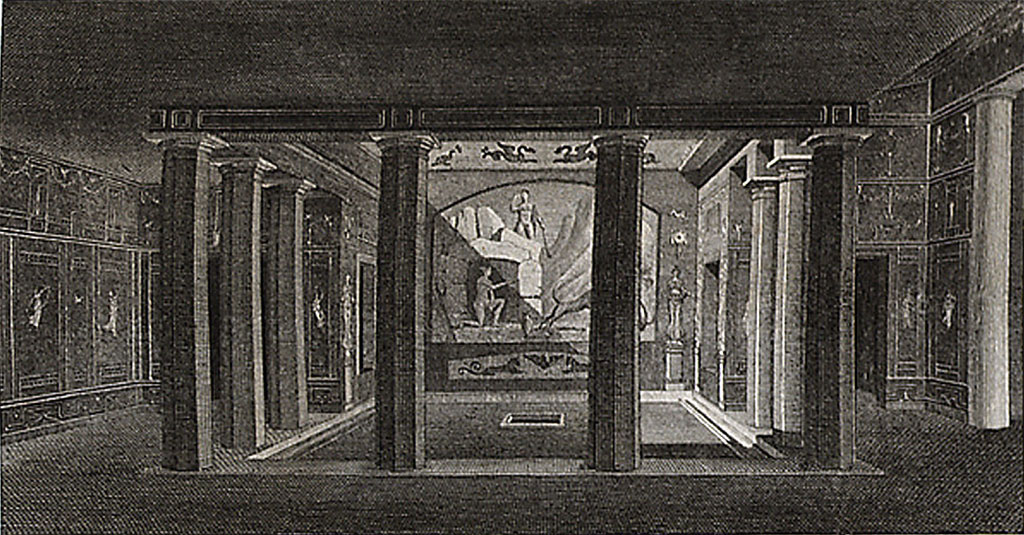
VI.2.4 Pompeii. 1824. Drawing of garden, peristyle, rooms and painting of Diana and Acteon, looking south.
See Mazois, F., 1824. Les Ruines de Pompei: Second Partie. Paris: Firmin Didot. (pl. 39, 1).
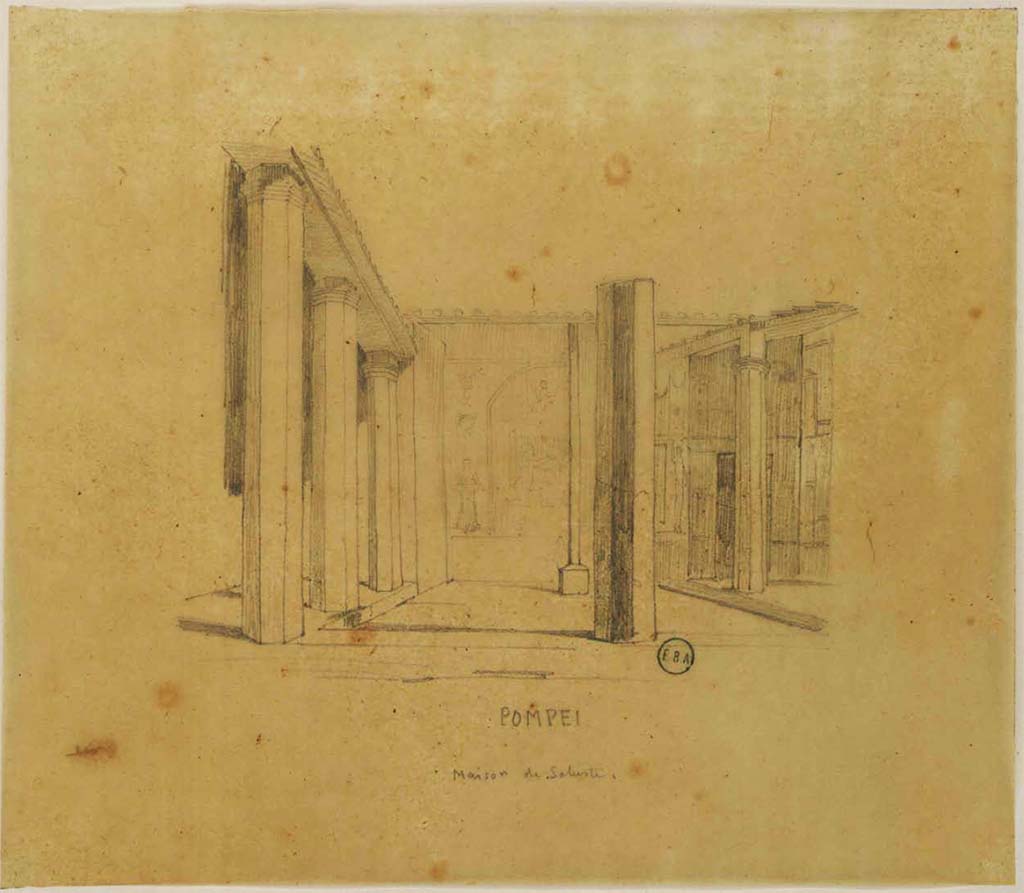
VI.2.4 Pompeii. Sketch of peristyle garden, looking south along east side.
See
Lesueur, Jean-Baptiste Ciceron. Voyage en Italie de Jean-Baptiste Ciceron
Lesueur (1794-1883), pl. 18.
See Book on INHA reference INHA NUM PC 15469 (04) « Licence Ouverte / Open Licence » Etalab
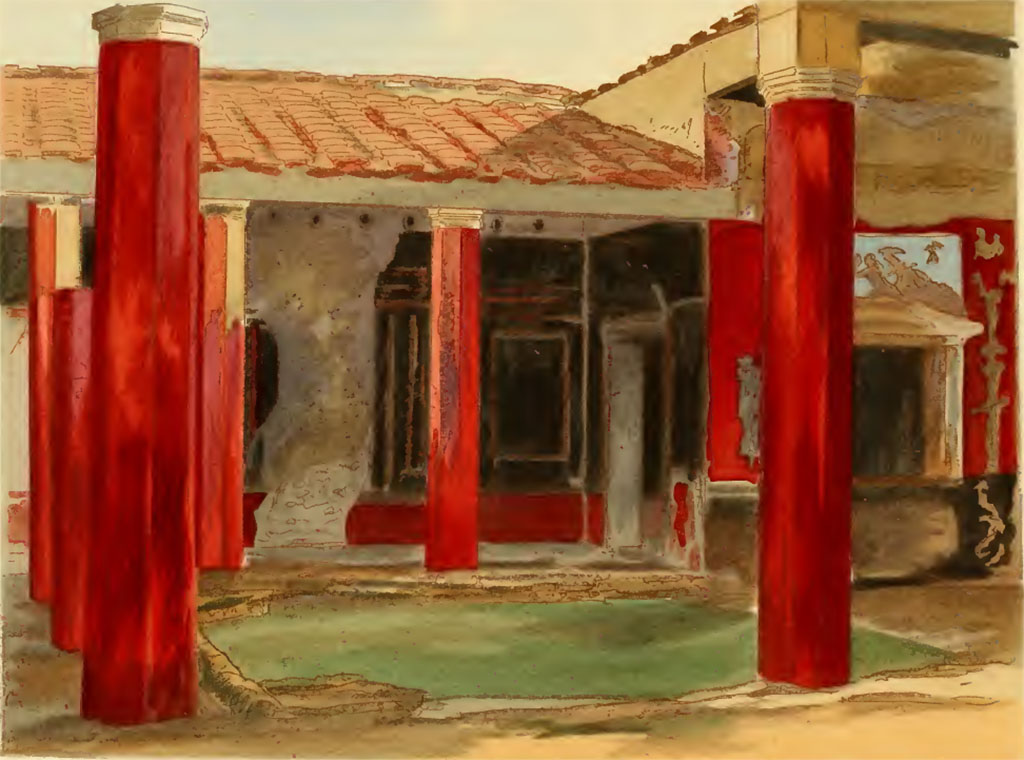
VI.2.4 Pompeii. Undated painting by Pierre Gusman. Looking towards east side of peristyle garden, with painting representing Europa, on the right.
(I. Peristylium
de la maison de Salluste. Le péristyle à droite, est fermé, sur son quatrième
côté, par une salle dont la muraille de fond est ornée d'une peinture
représentant Diane et Actéon. Premier style (Région VI, 2, 4).
See Gusman P.,
1924. La Décoration Murale de Pompei. Paris : Morancé, pl. I.
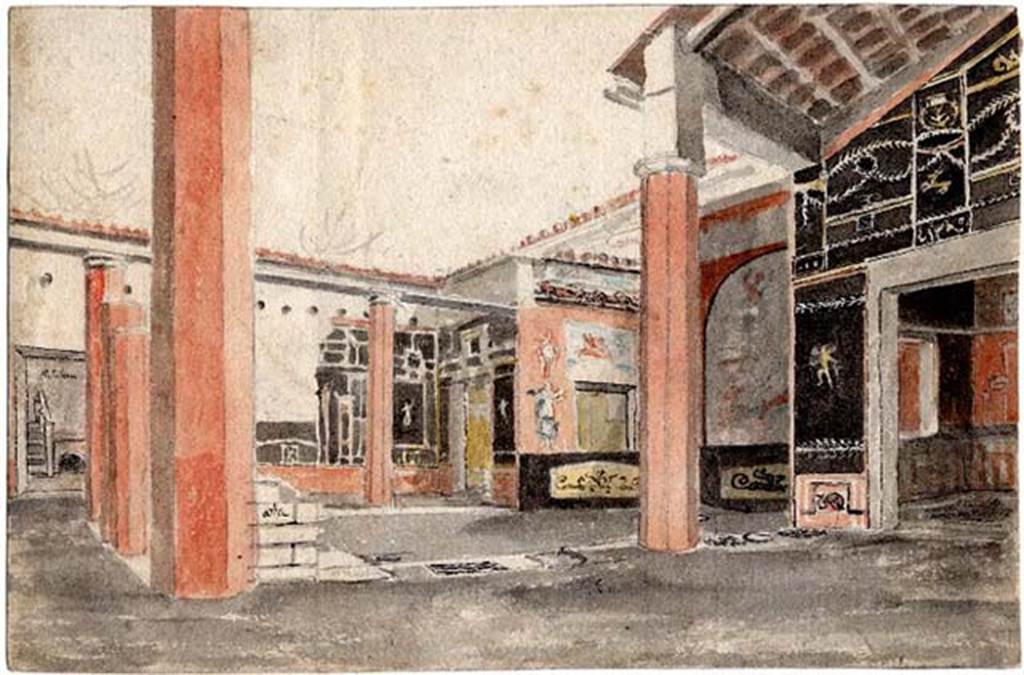
VI.2.4 Pompeii. 1824. Drawing of garden, peristyle, two diaeta rooms and area with painting of Diana and Acteon.
In the centre, above the window of the diaeta, the outline of Europa on the Bull can be seen.
Now in the British Museum. Inventory number 2011,5012.9.
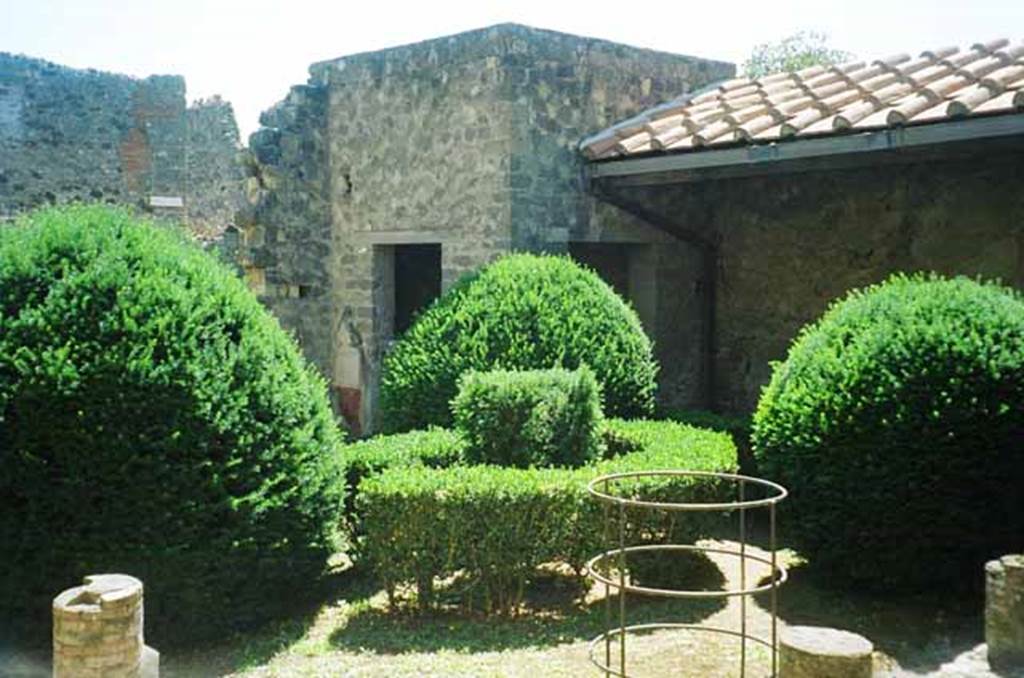
VI.2.4 Pompeii. June 2010. Looking south-east across the garden apartment towards cubiculum. Photo courtesy of Rick Bauer.
![VI.2.4 Pompeii. c.1819 sketch by William Gell described as being from “Surgeons House”, whereas “Europa” may be from VI.2.4.
There was a painting of Europa in the garden area above a side window of the cubiculum/diaeta in south-east corner of garden, which was completely destroyed in 1943.
The sketch on the right, “sitting man with cupid”, described by Gell as from the Surgeons House, he later described as may have been from House of the Vestals, VI.1.7.
See Gell W & Gandy, J.P: Pompeii published 1819 [Dessins publiés dans l'ouvrage de Sir William Gell et John P. Gandy, Pompeiana: the topography, edifices and ornaments of Pompei, 1817-1819], pl. 51.
See book in Bibliothèque de l'Institut National d'Histoire de l'Art [France], collections Jacques Doucet Gell Dessins 1817-1819
Use Etalab Open Licence ou Etalab Licence Ouverte](6%2002%2004%20p8_files/image035.jpg)
VI.2.4
Pompeii. c.1819 sketch by William Gell described as being from “Surgeons
House”, whereas “Europa” may be from VI.2.4.
There
was a painting of Europa in the garden area above a side window of the
cubiculum/diaeta in south-east corner of garden, which was completely destroyed
in 1943.
The
sketch on the right, “sitting man with cupid”, described by Gell as from the
Surgeons House, he later described as may have been from House of the Vestals,
VI.1.7.
See Gell W & Gandy, J.P: Pompeii published 1819 [Dessins publiés dans l'ouvrage de Sir William Gell et John P. Gandy, Pompeiana: the topography, edifices and ornaments of Pompei, 1817-1819], pl. 51.
See book in Bibliothèque de l'Institut National
d'Histoire de l'Art [France], collections Jacques Doucet Gell
Dessins 1817-1819
Use Etalab Open Licence ou
Etalab Licence Ouverte
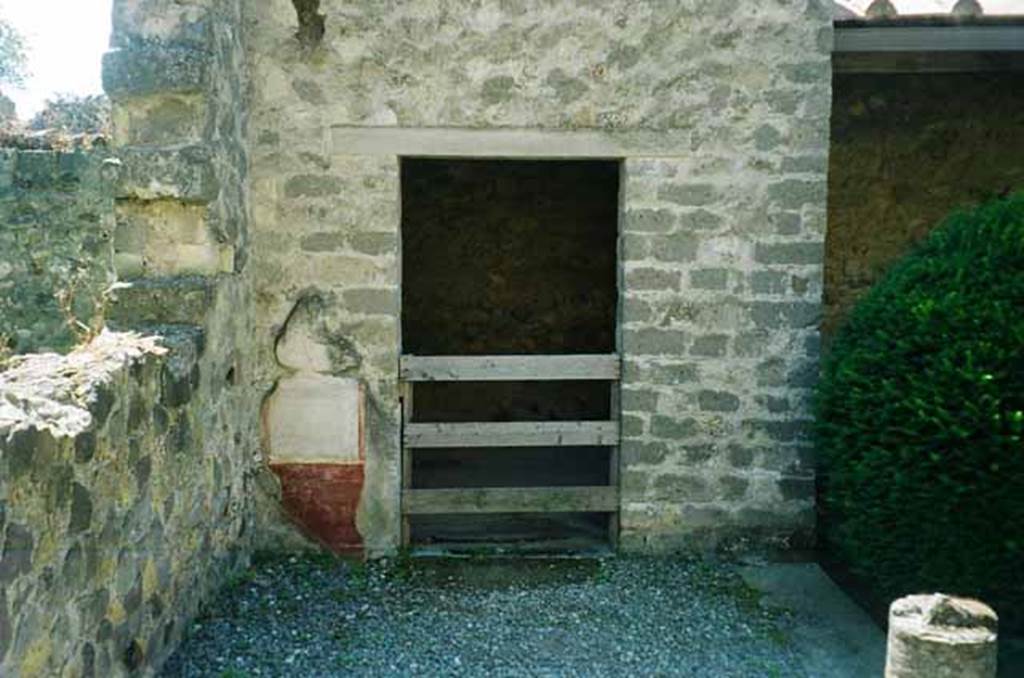
VI.2.4 Pompeii. June 2010. Doorway to cubiculum in south-east corner of garden apartment. Photo courtesy of Rick Bauer.
It should be noted that, apart from the west side, the house was entirely destroyed by the bombing during the night of 14/15th September 1943.
According to Laidlaw, the roof, the south apartment, and the portico behind the main house block are almost completely modern reconstructions made in 1970-71.
See Garcia y
Garcia, L., 2006. Danni di guerra a Pompei. Rome: L’Erma di Bretschneider. (p. 66-74).
According to Scafati –
“In the cubiculum to the left (the one in the south-east corner of garden area) were found, eight small columns of bronze and remains of gilt wood which formed part of a bed.”
See Scafati, Guide to Pompeii Illustrated, 1900. p.105-106.
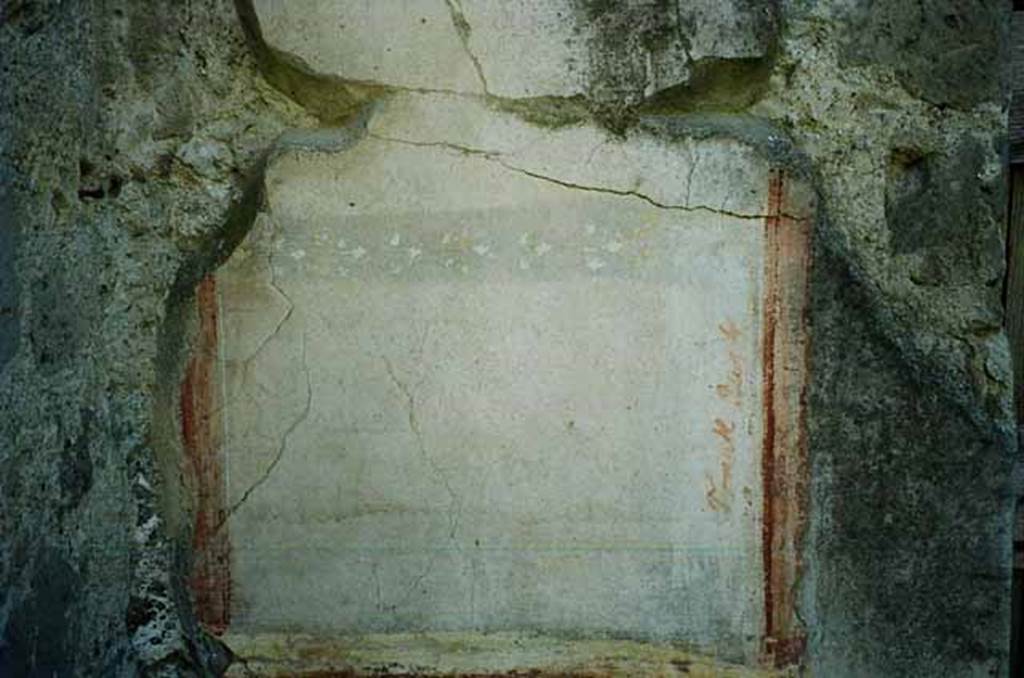
VI.2.4 Pompeii. June 2010. Painted plaster on outside wall of cubiculum, on the east side of the doorway. Photo courtesy of Rick Bauer.
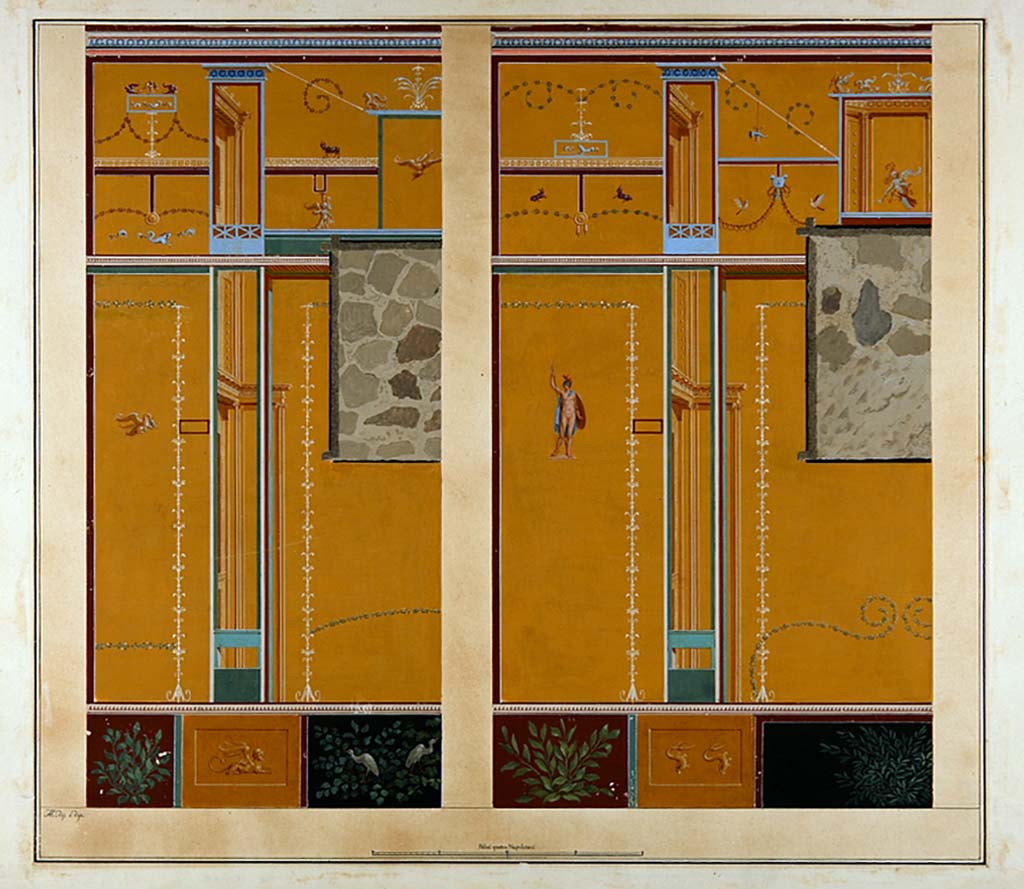
VI.2.4 Pompeii. C.1805 painting by F. Morelli of back and left walls in diaeta, now destroyed, in south-east corner of garden apartment.
Now in Naples Archaeological Museum. Inventory number ADS 125.
Photo © ICCD. https://www.catalogo.beniculturali.it
Utilizzabili alle condizioni della licenza Attribuzione
- Non commerciale - Condividi allo stesso modo 2.5 Italia (CC BY-NC-SA 2.5 IT)
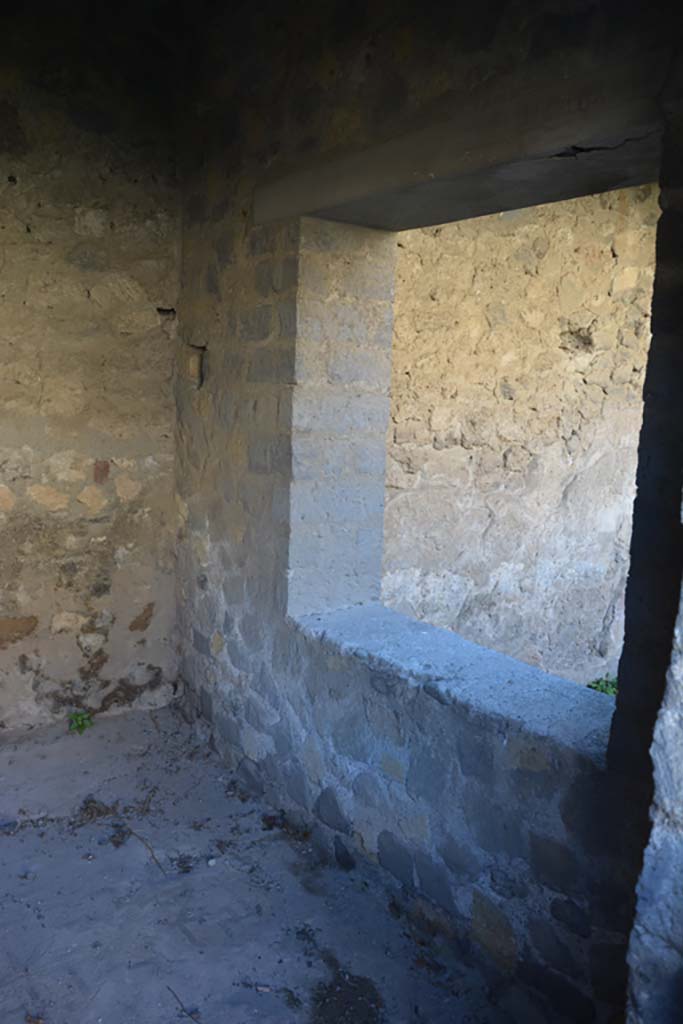
VI.2.4
Pompeii. December 2017. Looking towards window in west wall of cubiculum.
Foto Annette Haug, ERC Grant 681269 DÉCOR.
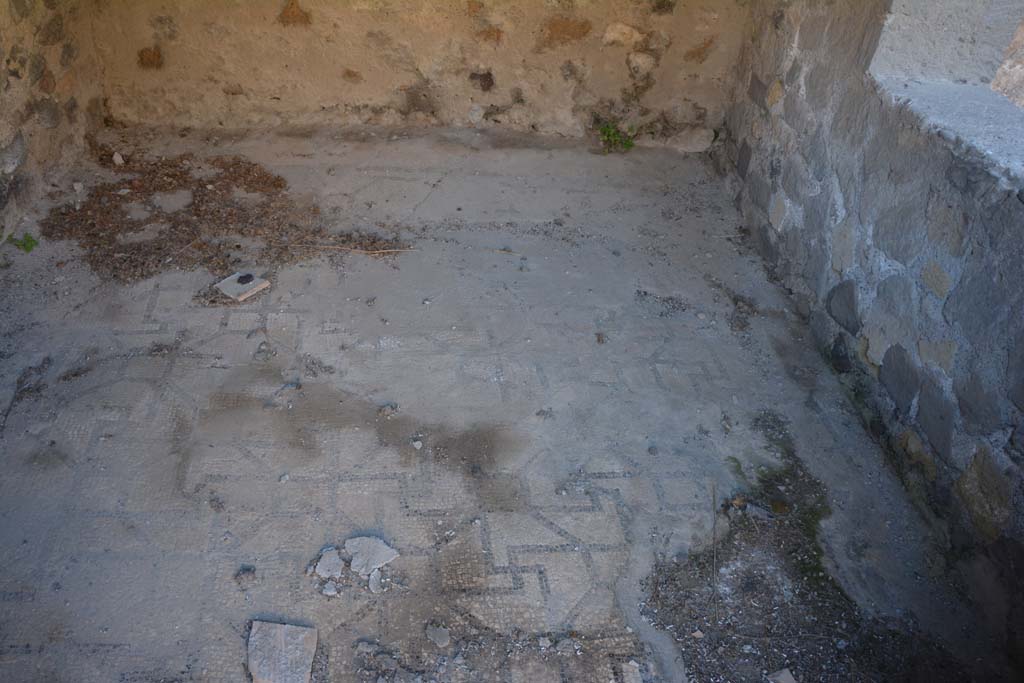
VI.2.4
Pompeii. March 2019. Looking south across floor mosaic in cubiculum.
Foto
Annette Haug, ERC Grant 681269 DÉCOR.
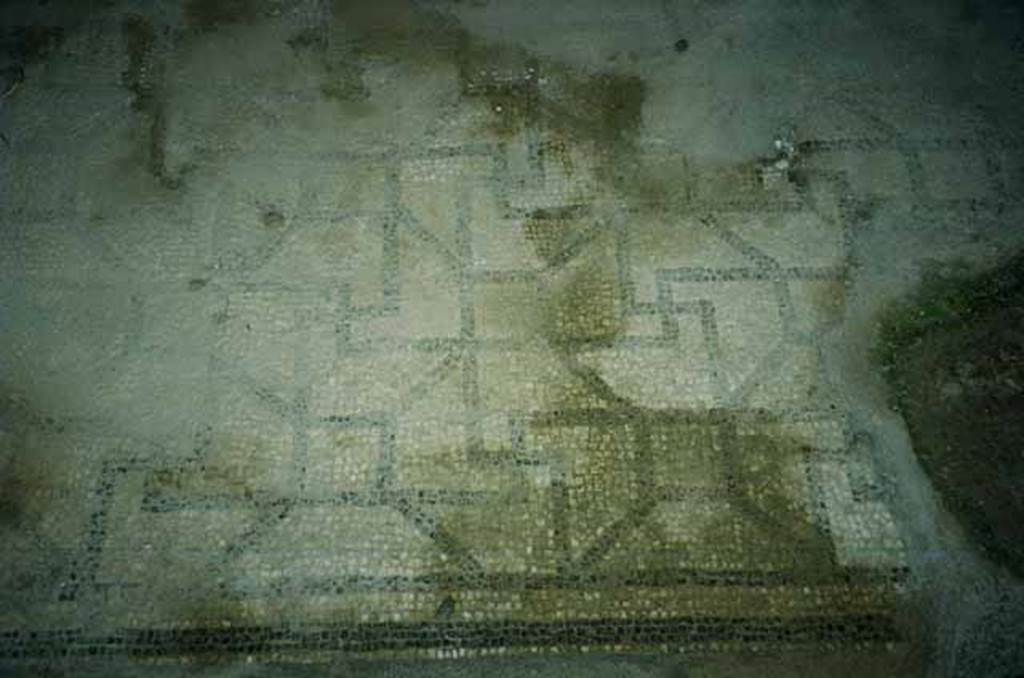
VI.2.4 Pompeii. June 2010. Floor mosaic in cubiculum. Photo courtesy of Rick Bauer.
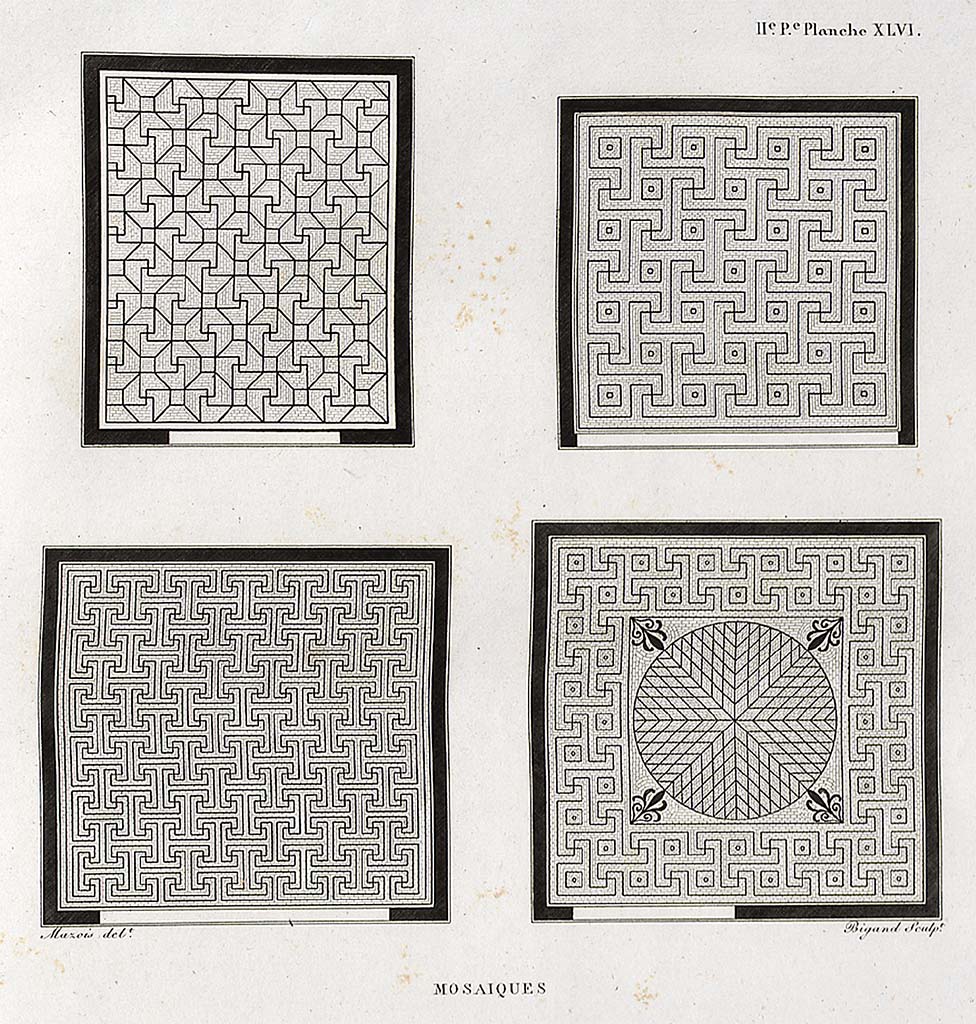
VI.2.4 Pompeii. c.1829. Drawing of mosaics by Mazois.
The mosaic on the top left, is possibly from Diaeta 33, (cubiculum
in south-east corner of garden area), a black and white mosaic.
Pl. XLVI, - the mosaic on the top right, may be from Villa of
Diomedes, no details of other lower two mosaics found yet.
See Mazois, F., 1824. Les
Ruines de Pompei : Second Partie. Paris : Firmin Didot, (p.88, Pl.
XLVI).
According to Laidlaw –
“Only fragments of the pavement of Diaeta 33 survived the bombing
in World War II.
When the debris was cleared in 1971, large chunks of the black and
white mosaic with a design of interlinked octagons and meanders were recovered
in situ, and the entire pattern was then restored, the interstices being filled
in on the basis of a pre-war photograph, Note 166 below.
Note 166: SAP Neg. No. C 990 (1917); PPM IV.1,134, fig.81, and see
also Pernice 1938, 38 with pl.10, fig.6.
In 1971, the Mason used tesserae found scattered in the rubble,
but when he ran out he got a couple of buckets from the nearby Casa della
Fontana Piccola (VI.8.23), where repairs were being made. Consequently, the
tesserae used in the restoration are a melange from the two houses.”
See Laidlaw, A., and Stella M. S., 2014. The House of Sallust in Pompeii (VI.2.4): JRA 98. Portsmouth Rhode Island. (p.110).
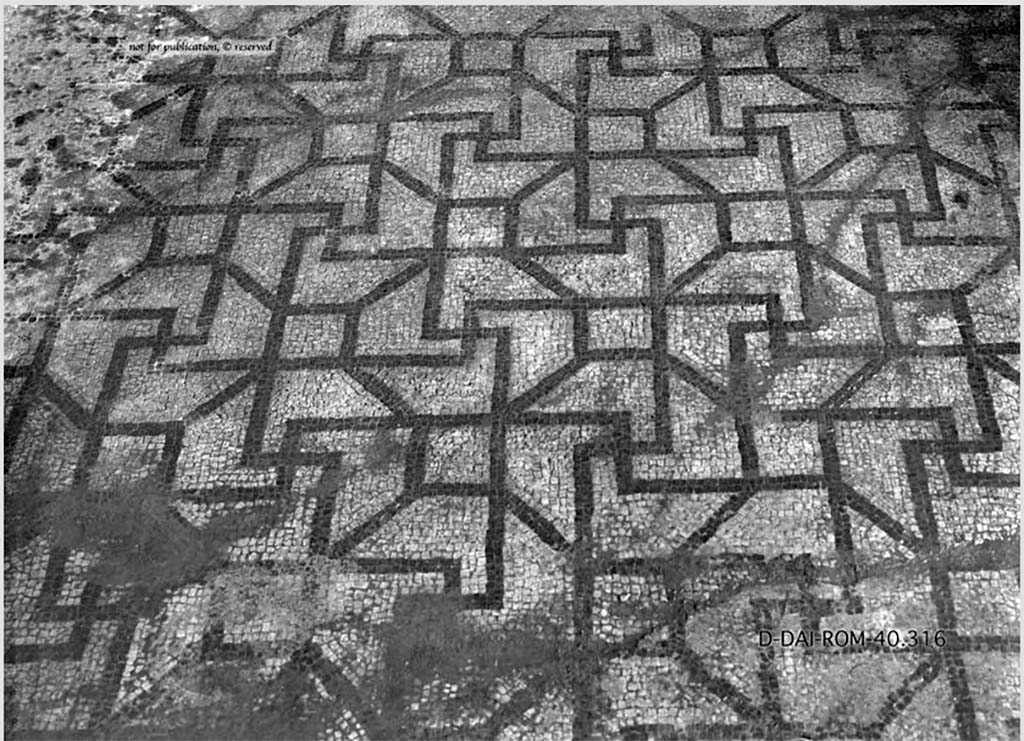
VI.2.4 Pompeii. 1938. Photo by Pernice of floor mosaic in diaeta/cubiculum 33.
See Pernice, E.,
1938. Pavimente und Figürliche Mosaiken: Die Hellenistische Kunst in Pompeji,
Band VI. Berlin: de Gruyter, Taf. 10,6.
DAIR 40.316.
Photo © Deutsches Archäologisches Institut, Abteilung Rom, Arkiv.
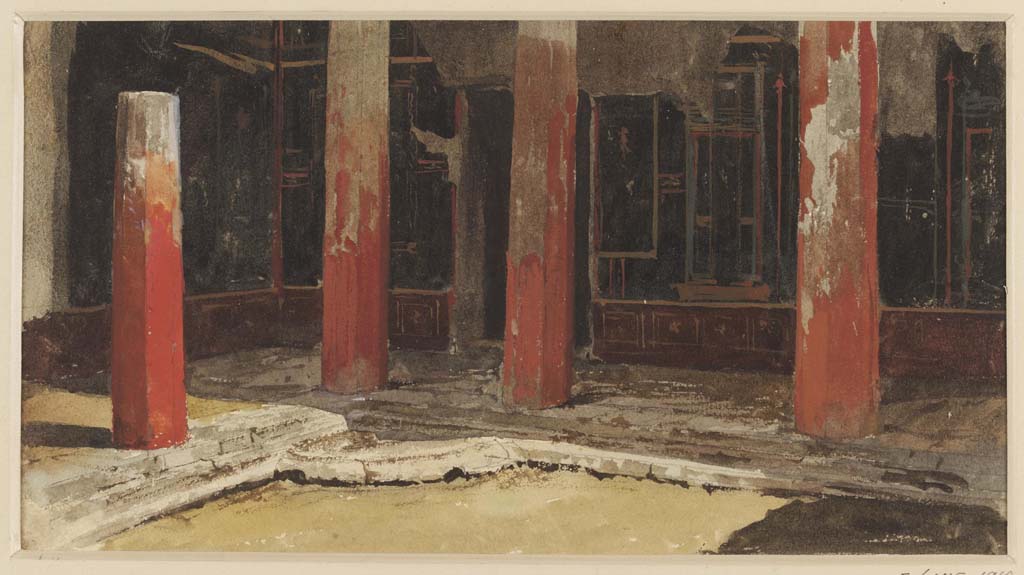
VI.2.4 Pompeii. Undated watercolour, by Luigi Bazzani, looking towards
north-east corner of the peristyle of the garden area/women's apartments.
Photo © Victoria and
Albert Museum. Inventory number 2054-1900.
Part 1 Part 2 Part 3 Part 4 Part 5 Part 6 Part 7 Part 8 Part 9 Plan